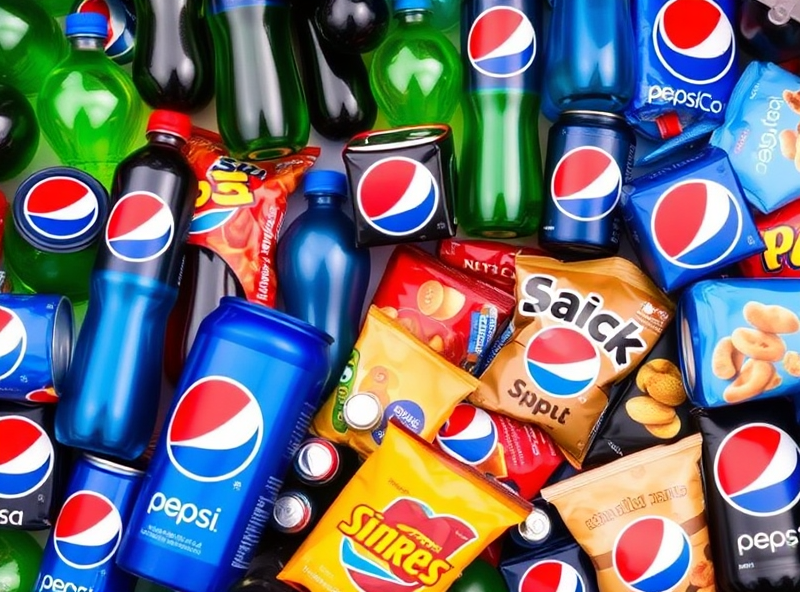
PepsiCo (PEP) Stock: More Than Just Soda? A Deep Dive for Investors

first thing that probably comes to mind is the iconic Pepsi cola. But just
like its main competitor, Coca-Cola, PepsiCo is a massive global beverage and
food company with a portfolio that extends far beyond its namesake soda. From
Lay’s potato chips and Doritos to Quaker Oats and Gatorade, PepsiCo owns a
vast array of popular brands that are staples in households around the world.
Understanding the breadth and depth of this portfolio is key for anyone
interested in PEP stock.
PepsiCo is a global food and beverage powerhouse operating in more
than 200 countries and territories. Their business model involves
manufacturing, marketing, and distributing a wide variety of snacks, foods,
and beverages. Unlike Coca-Cola, which primarily operates as a franchisor for
beverages, PepsiCo has significant manufacturing and distribution operations
for both its beverage and food businesses, particularly in North America.
This integrated model gives PepsiCo direct control over many aspects of its
supply chain and go-to-market strategy.
The food and beverage industry is characterized by intense
competition, evolving consumer tastes, and sensitivity to factors like
commodity costs, supply chain efficiency, and global economic conditions.
Investing in a company like PepsiCo means engaging with these dynamics and
understanding how the company plans to leverage its powerful brands,
extensive distribution networks, and innovation capabilities to drive future
growth and profitability. Let’s explore the different facets of PepsiCo’s
business and what they mean for investors.
Understanding PepsiCo’s Diverse Brand
Portfolio
PepsiCo’s strength lies in its incredibly diverse and popular
brand portfolio, spanning both beverages and convenient foods (snacks). While
Pepsi cola is a flagship brand, the company owns numerous other
billion-dollar brands that contribute significantly to its revenue and
profitability. In beverages, this includes not just Pepsi but also Diet
Pepsi, Mountain Dew, Gatorade, Tropicana (though some juice brands have been
divested in certain markets), Aquafina water, and Lipton teas (through a
partnership). This beverage portfolio allows PepsiCo to compete across
various categories, from carbonated soft drinks and sports drinks to water
and juices.
On the food side, PepsiCo is a dominant player in the global
snacks market through its Frito-Lay division. Brands like Lay’s, Doritos,
Cheetos, Tostitos, and Ruffles are incredibly popular and generate
substantial revenue. The Quaker Foods segment includes brands like Quaker
Oats, Aunt Jemima (though this brand is being retired/renamed), and
Rice-A-Roni, providing a presence in the breakfast and grains categories.
This combination of beverages and snacks is a unique strength for PepsiCo,
allowing for cross-promotional opportunities and providing diversification
across different consumer occasions and purchasing
habits.
This extensive and diverse brand portfolio is a significant
competitive advantage. It allows PepsiCo to cater to a wide range of consumer
preferences, capture market share across multiple categories, and leverage
its scale in marketing and distribution. The company continuously invests in
brand building, marketing campaigns, and product innovation to keep its
brands relevant and appealing to consumers around the
world.
Business Segments: Beverages, Snacks, and
Geography
PepsiCo reports its financial results across several key business
segments, reflecting its product categories and geographic operations. Major
segments include Frito-Lay North America (FLNA), Quaker Foods North America
(QFNA), PepsiCo Beverages North America (PBNA), Latin America, Europe,
Africa, Middle East and South Asia (AMESA), and Asia Pacific, Australia/New
Zealand and China (APAC). Understanding these segments helps illustrate how
PepsiCo generates revenue and its exposure to different markets and product
types.
FLNA is often the most profitable segment, benefiting from the
strong market position and pricing power of Frito-Lay snacks in the large
North American market. PBNA is the primary beverage business in North
America, competing directly with Coca-Cola. QFNA provides exposure to the
breakfast and grains market.
The international segments (Latin America, Europe, AMESA, APAC)
represent PepsiCo’s operations outside of North America, encompassing both
beverages and snacks. These regions offer significant growth opportunities,
particularly in emerging markets where consumer spending is rising and demand
for branded food and beverages is increasing. However, operating
internationally also means navigating different economic conditions, consumer
preferences, regulatory environments, and currency fluctuations in various
countries.
The mix of these segments, with the strong profitability of North
American snacks and the growth potential of international markets and
beverages, contributes to PepsiCo’s overall financial profile. The integrated
nature of its operations in many regions, particularly North America, is a
key differentiator compared to its main beverage
competitor.
Financial Performance and Stability
PepsiCo is often considered a defensive stock, similar to other
consumer staples companies. Demand for food and beverages tends to be
relatively stable even during economic downturns, as these are essential
items that people continue to purchase. This provides a level of resilience
to PepsiCo’s financial performance compared to companies selling
discretionary goods.
The company has a long history of consistent revenue growth,
driven by a combination of volume growth, pricing, and product mix. Its
scale, efficient operations, and strong brand portfolio contribute to healthy
gross margins and operating margins. Managing commodity costs (like sugar,
corn, and packaging materials) and supply chain efficiency are important
factors influencing profitability.
Key financial metrics for investors include total revenue, organic
revenue growth (excluding the impact of acquisitions, divestitures, and
currency fluctuations), segment-specific revenue growth, gross margin,
operating margin, net income, and earnings per share (EPS). Free cash flow
generation is also important for PepsiCo, indicating the cash available after
capital expenditures (investments in manufacturing, distribution, etc.) for
dividends, share buybacks, and debt management. PepsiCo has historically been
a strong generator of free cash flow, which is a key attraction for many
investors.
Shareholder Returns: Dividends and
Buybacks
PepsiCo has a strong track record of returning value to its
shareholders, primarily through dividends and share buybacks. The company is
a “Dividend King,” having increased its annual dividend for over 50
consecutive years. This remarkable history demonstrates the company’s
financial discipline and its deep commitment to shareholders, supported by
the stability of its underlying business and consistent cash flow
generation.
For income-focused investors, PepsiCo’s reliable and growing
dividend is a major reason to own the stock. The dividend yield can fluctuate
with the stock price, but the consistent increase in the dividend payment
itself is a key indicator of the company’s underlying financial health and
its ability to generate sustainable cash flow over the long term. This
dividend history is a significant differentiator for PepsiCo and a testament
to the resilience of its business model.
Share buybacks are also a significant component of PepsiCo’s
capital allocation strategy. By repurchasing its own shares on the open
market, the company reduces the number of outstanding shares, which can help
boost earnings per share and potentially increase the stock price over time.
The level of buybacks can vary depending on the company’s profitability, cash
flow, and strategic investment needs. PepsiCo’s capital allocation strategy
prioritizes investing in the business for long-term growth, followed by
returning a significant portion of free cash flow to shareholders through
dividends and buybacks.
Innovation and Adapting to Consumer
Trends
The food and beverage industry is constantly influenced by
changing consumer tastes and preferences. PepsiCo must continuously innovate
and adapt its product offerings to stay relevant. This includes developing
new flavors, introducing lower-sugar or healthier options (like baked chips
or non-carbonated beverages), expanding into new categories (like energy
drinks or plant-based snacks), and developing sustainable packaging
solutions.
PepsiCo leverages its R&D capabilities and market insights to
identify emerging trends and bring new products to market. Successful
innovation is crucial for driving organic revenue growth and maintaining
market share in a competitive environment. The company also uses digital
marketing and e-commerce strategies to reach consumers and sell its products
through online channels, adapting to changing retail
landscapes.
Competition and Risks
Despite its dominant position, PepsiCo operates in a highly
competitive market. In beverages, its primary global competitor is The
Coca-Cola Company, but it also competes with numerous other beverage
companies, including those selling water, juice, tea, coffee, and energy
drinks. In snacks, it competes with other large food companies (like
Mondelez, Kellogg’s) and numerous smaller, regional, and private label snack
brands.
Competition is based on factors like brand strength, pricing,
product innovation, marketing effectiveness, and distribution capabilities.
Economic downturns can impact consumer spending, potentially leading to
down-trading to cheaper alternatives, although demand for staples is
relatively stable. Rising commodity costs, supply chain disruptions, and
currency fluctuations from international operations can impact profitability.
Regulatory changes related to food and beverage labeling, ingredients (like
sugar), or marketing practices can also affect the business in various
markets.
Conclusion: A Diversified Consumer Staples
Powerhouse
In conclusion, PepsiCo (PEP) is a global food and beverage
powerhouse with an incredibly diverse portfolio of iconic brands spanning
both beverages and convenient foods. Its business model, which includes
significant manufacturing and distribution capabilities, particularly in
North America, provides a degree of control over its operations. The company
benefits from the stable demand for consumer staples, strong brand
recognition, and efficient operations, contributing to consistent financial
performance and robust free cash flow generation. PepsiCo is also known for
its exceptional track record of returning value to shareholders through a
consistently growing dividend and share buybacks.
For investors seeking exposure to the consumer staples sector with
a focus on a diversified company involved in both beverages and snacks,
understanding PepsiCo’s broad brand portfolio, its integrated business model,
its key growth markets (particularly international), its efforts to innovate
and adapt to consumer trends, and its financial discipline is essential for
evaluating its potential as a long-term investment. Despite the inherent
risks in the food and beverage industry and intense competition, PepsiCo’s
established position, diverse offerings, and commitment to shareholder
returns make it a significant company to consider.







